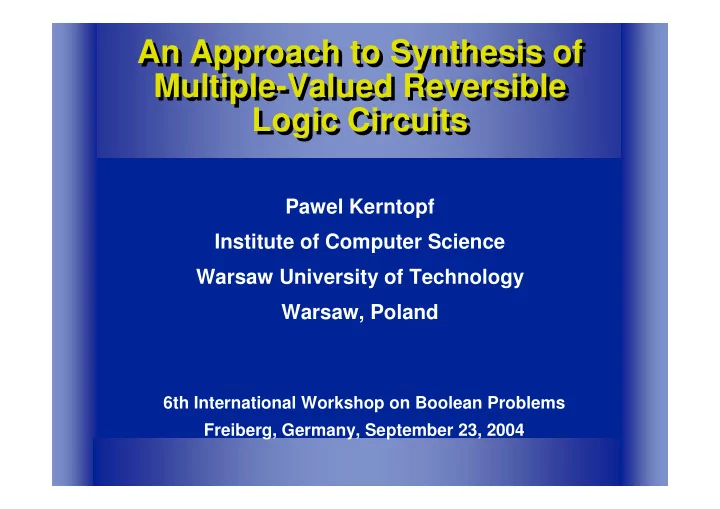

An Approach to Synthesis of An Approach to Synthesis of Multiple-Valued Reversible Multiple-Valued Reversible Logic Circuits Logic Circuits Pawel Kerntopf Institute of Computer Science Warsaw University of Technology Warsaw, Poland 6th International Workshop on Boolean Problems Freiberg, Germany, September 23, 2004
Overview Overview � Motivation � Reversible circuits � Reversible vs. classical logic synthesis � Basic binary reversible gates and libraries � Previous work � Assumptions � New complexity measure � Heuristic algorithm � MDDs with cyclic negations � Conclusions
Motivation Motivation � Reversible circuits enable to reduce energy dissipation (R. Landauer 1961, C. Bennett 1973) � Quantum processes are inherently reversible (R. Feynman 1985) � Logic synthesis for classical reversible circuits is a first step toward synthesis of quantum circuits � Some important processing tasks are reversible (V.V. Shende, A.K. Prasad, I.L. Markov, J.P. Hayes, TCAD 2003) � Digital signal processing � Cryptography � Communication � Computer graphics
Reversible circuits Reversible circuits � A circuit (a gate) is reversible iff it realizes a bijective mapping of inputs vectors into output vectors of a truth table of the circuit (gate) � # inputs = # outputs � reversible circuit consists only of reversible gates � fan-out of each output = 1 � reversible circuits are cascade circuits � Realization of arbitrary circuits (including irreversible) sometimes requires � creation of additional output wires („garbage”) � application of constant signals to some inputs � application of temporary storage (i.e. wires that can be changed during computation, but must be restored by end of the computation)
Basic reversible gates and libraries Basic reversible gates and libraries � (a) NOT (N) a’ = 1 ⊕ ⊕ a ⊕ ⊕ � (b) CNOT (C) a’ = a, b’ = a ⊕ ⊕ b ⊕ ⊕ � (c) Toffoli (T) a’ = a, b’ = b, c’ = c ⊕ ⊕ ab ⊕ ⊕ � (d) SWAP (S) a’ = b, b’ = a � (e) Fredkin (F) a’ = a, if a = 0 then b’ = b, c’ = c, if a = 1 then b’ = c, c’ = b Basic gate libraries: NCT, NCTS, NCTSF
Previous work Previous work � K. Iwama, Y. Kambayashi, S. Yamashita DAC’02 � equivalent transformations of reversible circuits � canonical form � no synthesis algorithm � V.V. Shende, A.K. Prasad, I.L. Markov, J.P. Hayes ICCAD’02 � synthesis of optimal 3-wire reversible circuits � can be used to generate libraries of small optimal ckts. � not implemented for larger functions � D.M. Miller, D. Maslov, G. Dueck DAC’03, ISMVL’04 � 2-stage transformation-based algorithm implemented (called here the DMM algorithm) � A. Agrawal, N.K. Jha DATE’04 � a synthesis algorithm based on PPRM expressions
Assumptions Assumptions � Reversible specifications that can be realized without additional wires (as in the previous algorithms) � Libraries: NCT, NCTS, NCTSF � Cost of a circuit is its gate count � Incremental approach to improve results of the first stage of the DMM algorithm � At each step of the new algorithm the selection of which gate to add next is guided by minimizing the complexity of the remainder function � New complexity measure based on using decision diagrams to represent a reversible function (instead of using truth tables or PPRM expressions, as in the previous algorithms)
New complexity measure (1) New complexity measure (1) � Definition The complexity measure of a completely specified n -input n -output reversible Boolean function f is equal to D ( f ) = s ( f ) – n , where s ( f ) denotes the number of non-terminal nodes in the reduced ordered shared binary decision diagram (SBDD) of f with complemented edges. � Remarks: 1) D(identity function) = 0 2) SBDDs with natural order of inputs � Example of an optimal circuit for NCTSF library:
New complexity measure (2) New complexity measure (2) � SBDDs of remainder functions for the example circuit:
New heuristic algorithm New heuristic algorithm � Sketch of one step of our algorithm � for each gate construct SBDD of the remainder function � select gates for which the complexity measure of the remainder function is minimal (if there is more than one such gate, proceed with all of them) � Speeding-up improvements in our algorithm � functions with small D ( f ) can be implemented very fast � moving SWAP gates decreases # of gates considered
A way to determine A way to determine a reminder function a reminder function
Experimental results Experimental results � Promising results in comparison with the results obtained for the DMM algorithm in the following cases: � synthesis of 3-wire functions � two libraries: NCTS and NCTSF � one-directional and bi-directional versions of the algorithms � best results of the two one-directional algorithms
Example MVL circuits Example MVL circuits � Two ternary reversible circuits (the circuit shown in Figure a is the inverse of the circuit shown in Figure b ). � All the gates in these circuits are controlled gates corresponding to quantum realizable gates.
CSMDDs of reminder functions CSMDDs of reminder functions � Cyclic negations: C k ( x ) = ( x + k ) mod p , 0 < k < p
Conclusions and future work Conclusions and future work � Our algorithm has better potential than previously reported algorithms due to using decision diagrams as a representation of reversible functions (instead of truth tables or PPRM expressions) � Our algorithm works for: � arbitrary libraries � arbitrary cost functions � Future work � modifications of our complexity measure to incorporate more data for obtaining better efficiency of the synthesis algorithm
Recommend
More recommend